methylprednisolone acetate
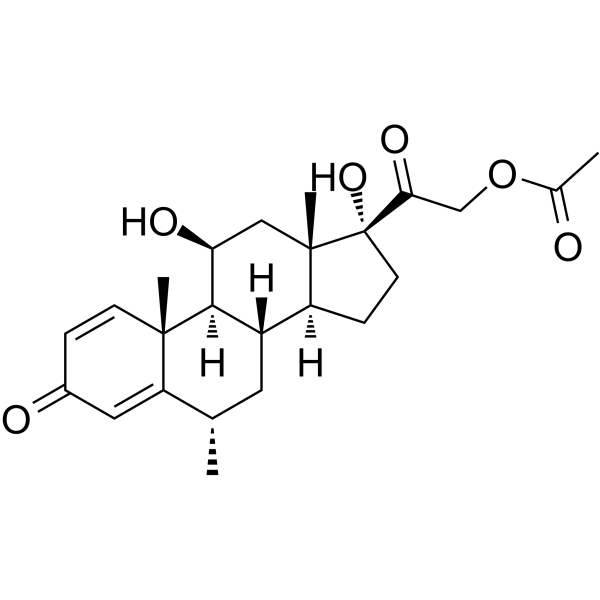
methylprednisolone acetate structure
|
Common Name | methylprednisolone acetate | ||
|---|---|---|---|---|
| CAS Number | 53-36-1 | Molecular Weight | 416.507 | |
| Density | 1.3±0.1 g/cm3 | Boiling Point | 582.5±50.0 °C at 760 mmHg | |
| Molecular Formula | C24H32O6 | Melting Point | 206ºC | |
| MSDS | Chinese USA | Flash Point | 196.5±23.6 °C | |
| Symbol |

GHS08 |
Signal Word | Warning | |
Use of methylprednisolone acetateMethylprednisolone acetate, a prednisolone derivative, is a corticosteroid hormone. Methylprednisolone acetate can relieve pain and swelling that occurs with arthritis and other joint disorders in vivo[1][2]. |
| Name | methylprednisolone acetate |
|---|---|
| Synonym | More Synonyms |
| Description | Methylprednisolone acetate, a prednisolone derivative, is a corticosteroid hormone. Methylprednisolone acetate can relieve pain and swelling that occurs with arthritis and other joint disorders in vivo[1][2]. |
|---|---|
| Related Catalog | |
| In Vivo | Methylprednisolone acetate (30 mg/kg, intramuscular injection; additional oral doses of 13 mg/kg for 10 consecutive days)combines with LPS induces typical features of early AVN of the femoral head[2]. Animal Model: A mouse model of osteonecrotic femoral head induced by methylprednisolone and liposaccharide[2] Dosage: 30 mg/kg; 13 mg/kg for 10 consecutive days Administration: 30 mg/kg, intramuscular injection; additional oral doses of 13 mg/kg for 10 consecutive days Result: Lead to chondrocyte degeneration and fibrocartilage expression after 7 weeks. Increased the density of CD31 and VEGF-R2 markers in the femoral head. |
| References |
| Density | 1.3±0.1 g/cm3 |
|---|---|
| Boiling Point | 582.5±50.0 °C at 760 mmHg |
| Melting Point | 206ºC |
| Molecular Formula | C24H32O6 |
| Molecular Weight | 416.507 |
| Flash Point | 196.5±23.6 °C |
| Exact Mass | 416.219879 |
| PSA | 100.90000 |
| LogP | 3.08 |
| Vapour Pressure | 0.0±3.7 mmHg at 25°C |
| Index of Refraction | 1.580 |
| InChIKey | PLBHSZGDDKCEHR-LFYFAGGJSA-N |
| SMILES | CC(=O)OCC(=O)C1(O)CCC2C3CC(C)C4=CC(=O)C=CC4(C)C3C(O)CC21C |
| Storage condition | Refrigerator |
|
Section 1. Chemical Product and Company Identification Methylprednisolone acetateCatalog ME171 Common Name/ Number(s). Trade Name CAS#53-36-1
Manufacturer RTECSTU4154050 SPECTRUM CHEMICAL MFG. CORP. TSCATSCA 8(b) inventory: Methylprednisolone acetate Commercial Name(s)Not available. CI# Not available. Synonym11,17,21-Trihydroxy-6-methyl-1,4-pregnadiene-3,20-dione acetate IN CASE OF EMERGENCY Not available. Chemical Name Chemical FamilyNot available.CALL (310) 516-8000 C24H32O6 Chemical Formula SPECTRUM CHEMICAL MFG. CORP. Section 2.Composition and Information on Ingredients Exposure Limits TWA (mg/m3)STEL (mg/m3) CEIL (mg/m3) NameCAS #% by Weight 1) Methylprednisolone acetate53-36-1100 Toxicological DataMethylprednisolone acetate on IngredientsLD50: Not available. LC50: Not available. Section 3. Hazards Identification Potential Acute Health Effects Hazardous in case of skin contact (irritant, permeator), of eye contact (irritant), of ingestion, of inhalation. Potential Chronic HealthHazardous in case of skin contact (irritant, permeator), of eye contact (irritant), of ingestion, of inhalation. EffectsCARCINOGENIC EFFECTS: Not available. MUTAGENIC EFFECTS: Not available. TERATOGENIC EFFECTS: Not available. DEVELOPMENTAL TOXICITY: Not available. Methylprednisolone acetate Section 4. First Aid Measures Eye ContactCheck for and remove any contact lenses. Do not use an eye ointment. Seek medical attention. Skin ContactAfter contact with skin, wash immediately with plenty of water. Gently and thoroughly wash the contaminated skin with running water and non-abrasive soap. Be particularly careful to clean folds, crevices, creases and groin. Cover the irritated skin with an emollient. If irritation persists, seek medical attention. Wash contaminated clothing before reusing. Serious Skin ContactWash with a disinfectant soap and cover the contaminated skin with an anti-bacterial cream. Seek medical attention. InhalationAllow the victim to rest in a well ventilated area. Seek immediate medical attention. Serious InhalationNot available. IngestionDo not induce vomiting. Loosen tight clothing such as a collar, tie, belt or waistband. If the victim is not breathing, perform mouth-to-mouth resuscitation. Seek immediate medical attention. Serious IngestionNot available. Section 5. Fire and Explosion Data Flammability of the Product May be combustible at high temperature. Auto-Ignition Temperature Not available. Flash PointsNot available. Flammable LimitsNot available. These products are carbon oxides (CO, CO2). Products of Combustion Fire Hazards in Presence of Not available. Various Substances Explosion Hazards in Presence Risks of explosion of the product in presence of mechanical impact: Not available. of Various SubstancesRisks of explosion of the product in presence of static discharge: Not available. Fire Fighting MediaSMALL FIRE: Use DRY chemical powder. and InstructionsLARGE FIRE: Use water spray, fog or foam. Do not use water jet. Special Remarks onNot available. Fire Hazards Special Remarks on Explosion Not available. Hazards Section 6. Accidental Release Measures Small SpillUse appropriate tools to put the spilled solid in a convenient waste disposal container. Finish cleaning by spreading water on the contaminated surface and dispose of according to local and regional authority requirements. Large Spill Use a shovel to put the material into a convenient waste disposal container. Finish cleaning by spreading water on the contaminated surface and allow to evacuate through the sanitary system. Methylprednisolone acetate Section 7. Handling and Storage PrecautionsKeep away from heat. Keep away from sources of ignition. Empty containers pose a fire risk, evaporate the residue under a fume hood. Ground all equipment containing material. Do not breathe dust. Wear suitable protective clothing In case of insufficient ventilation, wear suitable respiratory equipment If you feel unwell, seek medical attention and show the label when possible. Avoid contact with skin and eyes StorageKeep container dry. Keep in a cool place. Ground all equipment containing material. Keep container tightly closed. Keep in a cool, well-ventilated place. Combustible materials should be stored away from extreme heat and away from strong oxidizing agents. Section 8. Exposure Controls/Personal Protection Engineering ControlsUse process enclosures, local exhaust ventilation, or other engineering controls to keep airborne levels below recommended exposure limits. If user operations generate dust, fume or mist, use ventilation to keep exposure to airborne contaminants below the exposure limit. Personal ProtectionSplash goggles. Lab coat. Dust respirator. Be sure to use an approved/certified respirator or equivalent. Gloves. Personal Protection in Case of Splash goggles. Full suit. Dust respirator. Boots. Gloves. A self contained breathing apparatus should be used a Large Spillto avoid inhalation of the product. Suggested protective clothing might not be sufficient; consult a specialist BEFORE handling this product. Exposure LimitsNot available. Section 9. Physical and Chemical Properties Physical state and appearance Solid. (Crystalline solid.)OdorNot available. TasteNot available. 416.51 g/mole Molecular Weight ColorWhite. pH (1% soln/water)Not applicable. Boiling PointDecomposes. Melting Point206°C (402.8°F) Critical TemperatureNot available. Specific GravityNot available. Not applicable. Vapor Pressure Vapor DensityNot available. VolatilityNot available. Odor ThresholdNot available. Water/Oil Dist. Coeff.Not available. Not available. Ionicity (in Water) Dispersion PropertiesNot available. Very slightly soluble in methanol, acetone. Solubility Insoluble in cold water. Section 10. Stability and Reactivity Data StabilityThe product is stable. Instability TemperatureNot available. Conditions of InstabilityNot available. Incompatibility with various Not available. substances Methylprednisolone acetate Non-corrosive in presence of glass. Corrosivity Special Remarks onNot available. Reactivity Special Remarks onNot available. Corrosivity No. Polymerization Section 11. Toxicological Information Routes of EntryDermal contact. Eye contact. Inhalation. Ingestion. Toxicity to AnimalsLD50: Not available. LC50: Not available. Chronic Effects on Humans Not available. Other Toxic Effects onHazardous in case of skin contact (irritant, permeator), of ingestion, of inhalation. Humans Special Remarks onNot available. Toxicity to Animals Special Remarks onNot available. Chronic Effects on Humans Special Remarks on otherNot available. Toxic Effects on Humans Section 12. Ecological Information Not available. Ecotoxicity BOD5 and CODNot available. Products of BiodegradationPossibly hazardous short term degradation products are not likely. However, long term degradation products may arise. Toxicity of the ProductsThe products of degradation are more toxic. of Biodegradation Special Remarks on theNot available. Products of Biodegradation Section 13. Disposal Considerations Waste Disposal Section 14. Transport Information DOT ClassificationNot a DOT controlled material (United States). IdentificationNot applicable. Special Provisions forNot applicable. Transport Methylprednisolone acetate DOT (Pictograms) Section 15. Other Regulatory Information and Pictograms TSCA 8(b) inventory: Methylprednisolone acetate Federal and State Regulations CaliforniaCalifornia prop. 65: This product contains the following ingredients for which the State of California has found to cause cancer which would require a warning under the statute: No products were found. Proposition 65 Warnings California prop. 65: This product contains the following ingredients for which the State of California has found to cause birth defects which would require a warning under the statute: No products were found. Other RegulationsNot available.. WHMIS (Canada) Not controlled under WHMIS (Canada). Other Classifications DSCL (EEC)R36/38- Irritating to eyes and skin. Health Hazard HMIS (U.S.A.)2 National Fire Protection 1 Flammability 1 Association (U.S.A.) Fire Hazard 2 0 Reactivity Health Reactivity 0 Specific hazard Personal Protection E WHMIS (Canada) (Pictograms) DSCL (Europe) (Pictograms) TDG (Canada) (Pictograms) ADR (Europe) (Pictograms) Protective Equipment Gloves. Lab coat. Dust respirator. Be sure to use an approved/certified respirator or equivalent. Methylprednisolone acetate SECTION 16 - ADDITIONAL INFORMATION N/A |
CHEMICAL IDENTIFICATION
HEALTH HAZARD DATAACUTE TOXICITY DATA
|
|
Achyranthes bidentata extract exerts osteoprotective effects on steroid-induced osteonecrosis of the femoral head in rats by regulating RANKL/RANK/OPG signaling.
J. Transl. Med. 12 , 334, (2014) Steroid-induced osteonecrosis of the femoral head (steroid-induced ONFH) presents great challenges due to the various effects of steroids on multi-system pathways involved into osteoblast differentiat... |
|
|
Cholesterol- and lanolin-rich diets may protect against steroid-induced osteonecrosis in rabbits.
Acta Orthop. 84(6) , 593-7, (2013) It remains controversial how hypercholesterolemia influences the development of steroid-induced osteonecrosis (ON). We investigated the role of hypercholesterolemia induced by a cholesterol-rich diet ... |
|
|
Notes from the field: Department of Defense response to a multistate outbreak of fungal meningitis--United States, October 2012.
MMWR Morb. Mortal. Wkly. Rep. 62(38) , 800-1, (2013) On October 1, 2012, the Department of Defense (DoD) learned of a multistate outbreak of fungal meningitis in persons who received injections of methylprednisolone acetate (MPA) from a single compoundi... |
| 2-[(6S,8S,9S,10R,11S,13S,14S,17R)-11,17-Dihydroxy-6,10,13-trimethyl-3-oxo-6,7,8,9,10,11,12,13,14,15,16,17-dodecahydro-3H-cyclopenta[a]phenanthren-17-yl]-2-oxoethylacetat |
| 6-METHYLPREDNISOLONE ACETATE |
| (6α,11β)-11,17-Dihydroxy-6-methyl-3,20-dioxopregna-1,4-dien-21-yl acetate |
| Methylprednisolone acetate |
| 21-Acetoxy-11b,17-dihydroxy-6a-methylpregna-1,4-diene-3,20-dione |
| (6a,11b)-21-(Acetyloxy)-11,17-dihydroxy-6-methylpregna-1,4-diene-3,20-dione |
| 6a-Methylprednisolone 21-Acetate |
| CH3CO2CH(CH3)CH2OCH3 |
| Depo-methylprednisolone |
| MFCD00144786 |
| EINECS 200-171-3 |
| Pregna-1,4-diene-3,20-dione, 21-(acetyloxy)-11,17-dihydroxy-6-methyl-, (6α,11β)- |
| 2-[(6S,8S,9S,10R,11S,13S,14S,17R)-11,17-dihydroxy-6,10,13-trimethyl-3-oxo-6,7,8,9,10,11,12,13,14,15,16,17-dodecahydro-3H-cyclopenta[a]phenanthren-17-yl]-2-oxoethyl acetate |
| acétate de 2-[(6S,8S,9S,10R,11S,13S,14S,17R)-11,17-dihydroxy-6,10,13-triméthyl-3-oxo-6,7,8,9,10,11,12,13,14,15,16,17-dodécahydro-3H-cyclopenta[a]phénanthrén-17-yl]-2-oxoéthyle |
| 6α-Methyl Prednisolone 21-Acetate |
| 6α-Methylprednisolone 21-acetate |
| Solsolona |
| Pregna-1,4-diene-3,20-dione, 11β,17,21-trihydroxy-6α-methyl-, 21-acetate (8CI) |
 CAS#:53-06-5
CAS#:53-06-5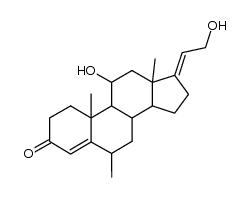 CAS#:3386-04-7
CAS#:3386-04-7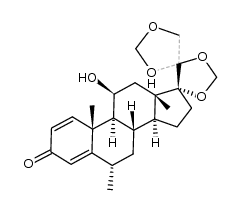 CAS#:117888-35-4
CAS#:117888-35-4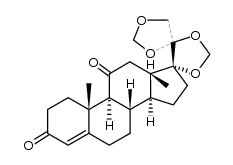 CAS#:3607-68-9
CAS#:3607-68-9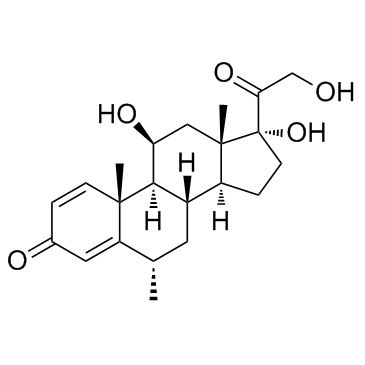 CAS#:83-43-2
CAS#:83-43-2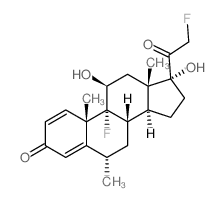 CAS#:359-80-8
CAS#:359-80-8 CAS#:382-52-5
CAS#:382-52-5